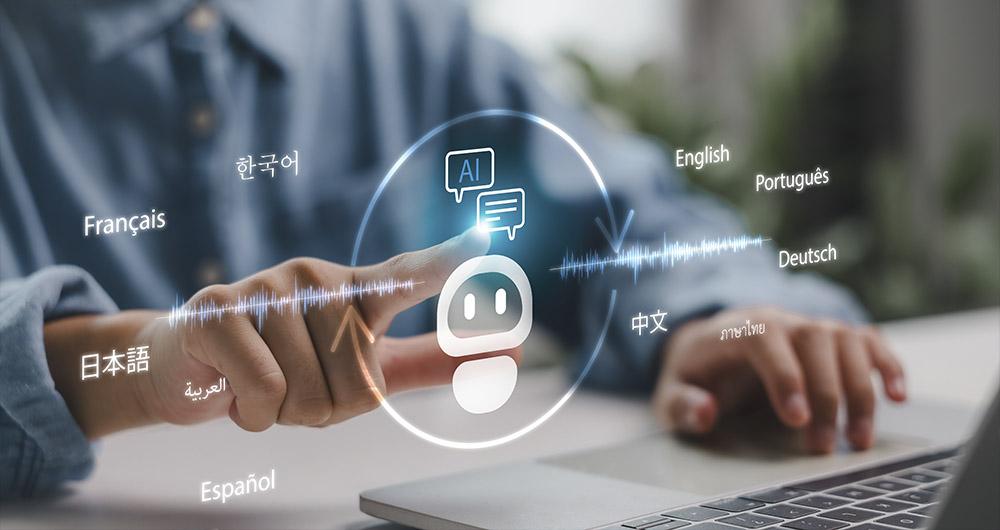
Artificial intelligence (AI) assistants are already part of our daily lives: we ask them the time, how to get to a certain place or we ask them to play our favorite song. And although AI, in the future, may offer us infinite functionalities, we must not forget that linguistic diversity is still a pending issue.
In Spain, where Spanish coexists with co-official languages such as Basque, Catalan, Valencian and Galician, this issue is especially relevant. The survival and vitality of these languages in the digital age depends, to a large extent, on their ability to adapt and be present in emerging technologies. Currently, most virtual assistants, automatic translators or voice recognition systems do not understand all the co-official languages. However, did you know that there are collaborative projects to ensure linguistic diversity?
In this post we tell you about the approach and the greatest advances of some initiatives that are building the digital foundations necessary for the co-official languages in Spain to also thrive in the era of artificial intelligence.
ILENIA, the coordinator of multilingual resource initiatives in Spain
The models that we are going to see in this post share a focus because they are part of ILENIA, a state-level coordinator that connects the individual efforts of the autonomous communities. This initiative brings together the projects BSC-CNS (AINA), CENID (VIVES), HiTZ (NEL-GAITU) and the University of Santiago de Compostela (NÓS), with the aim of generating digital resources that allow the development of multilingual applications in the different languages of Spain.
The success of these initiatives depends fundamentally on citizen participation. Through platforms such as Mozilla's Common Voice, any speaker can contribute to the construction of these linguistic resources through different forms of collaboration:
- Spoken Read: Collecting different ways of speaking through voice donations of a specific text.
- Spontaneous speech: creates real and organic datasets as a result of conversations with prompts.
- Text in language: collaborate in the transcription of audios or in the contribution of textual content, suggesting new phrases or questions to enrich the corpora.
All resources are published under free licenses such as CC0, allowing them to be used free of charge by researchers, developers and companies.
The challenge of linguistic diversity in the digital age
Artificial intelligence systems learn from the data they receive during their training. To develop technologies that work correctly in a specific language, it is essential to have large volumes of data: audio recordings, text corpora and examples of real use of the language.
In other publications of datos.gob.es we have addressed the functioning of foundational models and initiatives in Spanish such as ALIA, trained with large corpus of text such as those of the Royal Spanish Academy.
Both posts explain why language data collection is not a cheap or easy task. Technology companies have invested massively in compiling these resources for languages with large numbers of speakers, but Spanish co-official languages face a structural disadvantage. This has led to many models not working properly or not being available in Valencian, Catalan, Basque or Galician.
However, there are collaborative and open data initiatives that allow the creation of quality language resources. These are the projects that several autonomous communities have launched, marking the way towards a multilingual digital future.
On the one hand, the Nós en Galicia Project creates oral and conversational resources in Galician with all the accents and dialectal variants to facilitate integration through tools such as GPS, voice assistants or ChatGPT. A similar purpose is that of Aina in Catalonia, which also offers an academic platform and a laboratory for developers or Vives in the Valencian Community. In the Basque Country there is also the Euskorpus project , which aims to constitute a quality text corpus in Basque. Let's look at each of them.
Proyecto Nós, a collaborative approach to digital Galician
The project has already developed three operational tools: a multilingual neural translator, a speech recognition system that converts speech into text, and a speech synthesis application. These resources are published under open licenses, guaranteeing their free and open access for researchers, developers and companies. These are its main features:
- Promoted by: the Xunta de Galicia and the University of Santiago de Compostela.
- Main objective: to create oral and conversational resources in Galician that capture the dialectal and accent diversity of the language.
- How to participate: The project accepts voluntary contributions both by reading texts and by answering spontaneous questions.
- Donate your voice in Galician: https://doagalego.nos.gal
Aina, towards an AI that understands and speaks Catalan
With a similar approach to the Nós project, Aina seeks to facilitate the integration of Catalan into artificial intelligence language models.
It is structured in two complementary aspects that maximize its impact:
- Aina Tech focuses on facilitating technology transfer to the business sector, providing the necessary tools to automatically translate websites, services and online businesses into Catalan.
- Aina Lab promotes the creation of a community of developers through initiatives such as Aina Challenge, promoting collaborative innovation in Catalan language technologies. Through this call , 22 proposals have already been selected with a total amount of 1 million to execute their projects.
The characteristics of the project are:
- Powered by: the Generalitat de Catalunya in collaboration with the Barcelona Supercomputing Center (BSC-CNS).
- Main objective: it goes beyond the creation of tools, it seeks to build an open, transparent and responsible AI infrastructure with Catalan.
- How to participate: You can add comments, improvements, and suggestions through the contact inbox: https://form.typeform.com/to/KcjhThot?typeform-source=langtech-bsc.gitbook.io.
Vives, the collaborative project for AI in Valencian
On the other hand, Vives collects voices speaking in Valencian to serve as training for AI models.
- Promoted by: the Alicante Digital Intelligence Centre (CENID).
- Objective: It seeks to create massive corpora of text and voice, encourage citizen participation in data collection, and develop specialized linguistic models in sectors such as tourism and audiovisual, guaranteeing data privacy.
- How to participate: You can donate your voice through this link: https://vives.gplsi.es/instruccions/.
Gaitu: strategic investment in the digitalisation of the Basque language
In Basque, we can highlight Gaitu, which seeks to collect voices speaking in Basque in order to train AI models. Its characteristics are:
- Promoted by: HiTZ, the Basque language technology centre.
- Objective: to develop a corpus in Basque to train AI models.
- How to participate: You can donate your voice in Basque here https://commonvoice.mozilla.org/eu/speak.
Benefits of Building and Preserving Multilingual Language Models
The digitization projects of the co-official languages transcend the purely technological field to become tools for digital equity and cultural preservation. Its impact is manifested in multiple dimensions:
- For citizens: these resources ensure that speakers of all ages and levels of digital competence can interact with technology in their mother tongue, removing barriers that could exclude certain groups from the digital ecosystem.
- For the business sector: the availability of open language resources makes it easier for companies and developers to create products and services in these languages without assuming the high costs traditionally associated with the development of language technologies.
- For the research fabric, these corpora constitute a fundamental basis for the advancement of research in natural language processing and speech technologies, especially relevant for languages with less presence in international digital resources.
The success of these initiatives shows that it is possible to build a digital future where linguistic diversity is not an obstacle but a strength, and where technological innovation is put at the service of the preservation and promotion of linguistic cultural heritage.


